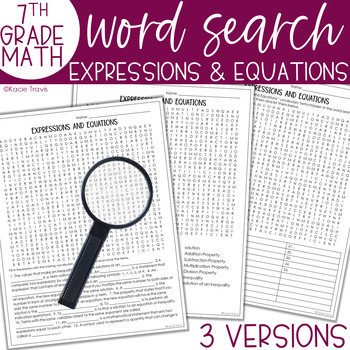Word Search Expressions and Equations 7th Grade Math Vocabulary
- PDF
Also included in
- Students need multiple exposures to new vocabulary to make it stick! This fun Word Find for 7th-grade math students helps them use their new vocabulary terms in a unique, yet meaningful way!This bundle features word searches for the vocabulary for each of the five strands of 7th-grade math. Each ofPrice $7.00Original Price $10.00Save $3.00
Description
Students need multiple exposures to new vocabulary to make it stick! This fun Word Find for 7th-grade math students helps them use their new pre-algebra vocabulary terms in a unique, yet meaningful way!
This product features a word search for 25 Expressions and Equations vocabulary terms. There are three convenient options from which you can choose or mix and match to meet differentiation needs:
- traditional word search with word bank
- word search with no bank and fill-in-the-blanks to find terms
- word search with no bank and students use prior knowledge to find all 56 terms
Wonderful for introducing vocabulary, reviewing before a test, or when you have a substitute! Great for Sub Plans - NO PREP!
Check the preview to see which terms are included.
All new products are 50% off for the first 24 hours! Click here to follow me for future updates and product alerts!
©Kacie Travis ©The Efficient Classroom All rights reserved. Purchase of this unit entitles the purchaser the right to reproduce the pages in limited quantities for classroom use only. Duplication for an entire school, an entire school system or commercial purposes is strictly forbidden without written permission from the publisher. Kacie Travis, Kacie_travis@yahoo.com
Copying any part of this product and placing it on the Internet in any form (even a personal/classroom website) is strictly forbidden and is a violation of the Digital Millennium Copyright Act (DMCA). These items can be picked up in a google search and then shared worldwide for free.






